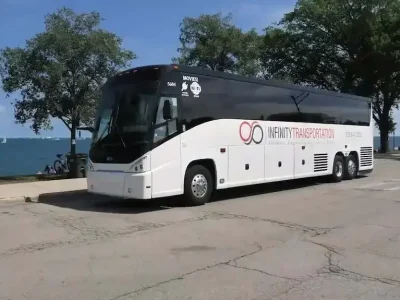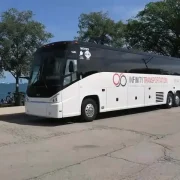Planning group travel is far simpler when you understand how seating options translate into real-world comfort, efficiency, and safety. The size and layout of your coach determine how your itinerary runs, which amenities you can enjoy, and how much your group pays per seat. By learning how Charter Bus Seating Capacity interacts with luggage, accessibility needs, and trip length, you can make confident choices. Operators like Infinity Transportation maintain diverse fleets, so aligning your needs with the right vehicle is achievable with a bit of clarity. This guide walks through sizes, configurations, legal limits, and budget trade-offs, so your group arrives together and on schedule without unnecessary compromises.
Choosing the Right Bus Size for Group Travel Needs
Selecting the correct vehicle starts with an accurate headcount and a realistic buffer. Always include chaperones, guides, and drivers’ assistants in your planning, and add 10–15 percent more seats to accommodate last-minute joins or unexpected needs. If your group is carrying instruments, samples, sports gear, or trade show materials, remember that storage demands can influence seating choices, especially on smaller buses. Think through accessibility as well: wheelchair positions, service animals, or mobility devices reshape interior space and boarding timelines. For longer trips, more legroom and a restroom can improve comfort but may reduce total seats. In short, Charter Bus Seating Capacity is more than a number; it’s a practical fit for your people, luggage, and route.
Core factors to consider before you book
Trip length is a defining element because comfort needs scale with time spent on the road. Short hops between venues may justify tighter seating, while multi-hour drives benefit from amenities like reclining seats, power outlets, and onboard Wi-Fi. The composition of your group matters too; adult travelers generally need more legroom than younger students, and tall passengers feel the difference of a few inches of seat pitch. If your event involves formal attire or bulky coats in colder months, factor in overhead space and under-bay storage. The number of stops and how frequently passengers board and disembark also affect which layout works best. When in doubt, choose a touch more space to reduce fatigue and streamline boarding.
Route constraints round out the selection process because not every bus fits every street or venue. Downtown hotels, historic districts, and campuses can impose height, curb space, and turning restrictions that make smaller coaches more practical. Likewise, event locations may have limited loading zones or require shuttles for last-mile transfers, shaping how many seats you truly need per vehicle. If your itinerary includes narrow roads, low clearances, or off-peak pickups, discuss vehicle dimensions with your operator early. Consider contingency planning for bad weather, staged luggage loading, or staggered departures to keep your schedule predictable. A carefully chosen size prevents delays and keeps your group moving together without stress.
Comparing Mini Buses, Mid-Size Coaches, and Full-Size Buses
Charter options loosely fall into three categories: mini buses, mid-size coaches, and full-size motorcoaches. Mini buses typically seat around 18–25 passengers (some reach the high 20s), favoring short-distance shuttles and quick venue loops. Mid-size coaches often range from roughly 28–38 seats, delivering a balance of maneuverability and amenities. Full-size coaches generally seat 40–56 passengers, offer large underfloor luggage bays, and handle highway miles with ease. The right pick depends on how you value agility, storage, comfort, and the total number of riders. Partnering with an experienced provider like Infinity Transportation helps translate these differences into the most reliable match for your itinerary.
Typical seating ranges and ideal use cases
Mini buses shine in dense city environments, airport transfers, and event shuttles where quick turns and smaller footprints matter. While they usually lack restrooms and underfloor bays, they make up for it with speed, nimble navigation, and efficient boarding for short rides. Wedding guest shuttles, conference breakouts, and campus circulators often rely on minis to keep groups moving on tight timetables. For small corporate teams or field visits, they minimize costs while avoiding multiple vehicles. Keep in mind that interior cargo space is limited, so large bags may require careful staging or separate transport. When your priorities are frequency and access, mini buses are often the most flexible choice.
Mid-size coaches offer more comfort and storage than minis while staying easier to park and maneuver than a full-size coach. They frequently include reclining seats, climate control, and overhead racks, with some models offering restrooms and modest under-bay space. This size is ideal for regional meetings, sports day trips, and mid-distance excursions where amenities matter but a full motorcoach feels excessive. Full-size coaches become the best fit when you need maximum seats, significant underfloor storage, and a restroom for long stretches. These larger buses handle tours, tournaments, and multi-day travel especially well, providing a smoother ride and more robust climate systems. If your group size fluctuates across a multi-day event, mix and match vehicles, and let Infinity Transportation coordinate staging so every leg fits the plan.
How Comfort and Amenities Affect Seating Configuration
Amenities shape seat counts and personal space in ways that are easy to overlook. Adding a restroom typically reduces capacity by a few seats, and installing a wheelchair lift or multiple securement areas changes the floorplan significantly. Enhanced legroom, footrests, and wider recliners further reduce total seating while improving passenger satisfaction on longer routes. Entertainment systems, power outlets, and Wi-Fi don’t consume seats directly, but the vehicle models that emphasize these features often pair them with generous seat pitch. Seat pitch, measured from one point on a seat to the same point on the seat ahead, can move the needle from cramped to comfortable. Because Charter Bus Seating Capacity reflects these trade-offs, the “same” bus size can feel very different across operators and models.
Layout choices that change available seats
The most common layout in full-size coaches is a “2-and-2” configuration, two seats on each side of the aisle. Premium configurations might convert some rows to a “2-and-1,” creating wider single seats and a more spacious aisle, but cutting total seats substantially. Conference-style pods or card tables at the front can substitute two to four seats for collaborative space, which is great for executive teams or coaching staff briefings. ADA configurations integrate one or more wheelchair positions and boarding lifts, preserving dignity and speed while reducing general seating by a handful of places. Some coaches offer larger luggage capacities with underfloor bays and overhead racks, which is a notable advantage for instruments or bulky event materials. When comparing quotes, ask for the floorplan so you see exactly where the space goes, not just the headline seat count.
Luggage is the wild card that often changes the math more than expected. Touring bands, school orchestras, or STEM teams with equipment can fill bays quickly, even on a full-size coach, and might need a trailer or additional vehicle support. A trailer doesn’t change seating directly, but it can lengthen the overall vehicle and influence routing, loading times, and parking arrangements. For film crews or trade shows, coordinating early dock access can prevent congestion and protect aisle space from carry-ons. Even for leisure travel, coolers, strollers, and personal bags accumulate fast, so plan for overflow. By thinking about where your gear will live, you’ll align layout and comfort with the actual realities of your group’s movement.
Safety and Legal Limits for Passenger Capacity Compliance
While capacity choices involve comfort and cost, they also carry legal obligations. Every coach displays a manufacturer’s or operator’s capacity rating that should never be exceeded, even by a single passenger. Highway safety rules typically forbid standing passengers on motorcoaches while in motion, and weight distribution must respect the vehicle’s gross ratings. Seat belts, now common on many newer buses, should be used according to local laws and company policy. Emergency exits, window hammers, and aisle widths are regulated for clear egress and must be kept unobstructed. Because Charter Bus Seating Capacity intersects with these standards, compliance is both a safety imperative and a contractual requirement.
What to verify with your operator
Before departure, confirm your carrier’s USDOT and operating authority numbers, insurance coverage, and inspection status. Ask about driver qualifications, hours-of-service adherence, and their plan for relief drivers on long-haul or overnight runs. Verify seat belt availability, ADA features, and how many securement positions are installed if you have mobility needs. For school or youth groups, understand supervision policies, emergency procedures, and any local requirements for safety briefings. Request clarity on bag storage rules so aisles and exits remain free throughout the trip. A reputable operator will welcome these questions and provide documentation without hesitation.
Some municipalities require special permits for large vehicles, designated pick-up points, or time windows for loading and unloading. Stadiums, arenas, and convention centers often have unique bus staging plans that affect where passengers board and disembark. On multi-state trips, rules can vary for lane access, idling, and even toll classification; your operator should navigate these in advance. Ensure your itinerary includes realistic stops for restrooms and driver breaks to maintain compliance and passenger well-being. If weather or traffic introduces delays, your carrier should have a plan that prioritizes safety and legal rest times. When safety and compliance are non-negotiable, the journey runs smoothly by design, not by chance.
Balancing Cost, Space, and Convenience for Every Trip
Budget decisions become clearer when you look at cost per seat, not just the total price of a bus. Minis can be cost-effective for short hops, but two minis may cost more than one mid-size or full coach after driver hours, staging, and tolls are included. The most expensive option is the one that fails your needs—too few seats, insufficient storage, or a vehicle that can’t access your venue. Seasonal demand, special events, and weekend peaks can also influence pricing, especially in major cities or during graduation and tournament periods. A clear itinerary with defined pick-up times and realistic loading windows reduces idle time and overtime charges. With transparent goals, you can right-size service and avoid paying for unused capacity.
Smart booking tactics
Book early when you can, especially if you need multiple vehicles or premium features like 2-and-1 seating or extra luggage capacity. Share a detailed schedule, including the number of bags, so your operator can propose the most efficient vehicles and staging plan. Limit scattered pick-ups when possible; consolidating stops reduces mileage and helps keep everyone on schedule. For events requiring steady movement, consider a shuttle loop rather than one-time transfers to maximize vehicle utilization. Be flexible on departure times if traffic patterns or venue rules suggest a better window. Clear choices like these preserve comfort, protect timelines, and optimize your total cost.
Evaluate the full picture rather than fixating on raw seat counts. A mid-size coach with better legroom may leave riders fresher for a presentation, while a full-size bus with underfloor bays eliminates the need for additional cargo solutions. If you’re balancing comfort with value, ask for a couple of layout options at different price points to see where the trade-offs land. Infinity Transportation can build quotes that reflect these variables, ensuring the final selection matches your group’s priorities and constraints. When you match the itinerary, luggage, and comfort expectations to the right vehicle, you get predictable costs and an easier day-of experience. The result is a trip where the vehicle supports the plan rather than dictating it—and where seat count serves the journey, not the other way around.













Comments